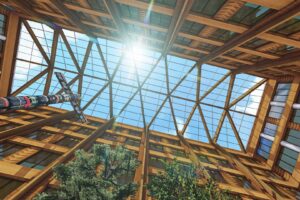 By Jacques Marcoux
By Jacques Marcoux
Winnipeggers will soon make history by stepping off the curb and crossing a street—an action that has been a forbidden act for more than four decades. On July 1, the iconic intersection of Portage Avenue and Main Street will reopen to pedestrian traffic, a move that promises to reshape the city’s downtown.
For Brent Bellamy, architect and creative director at Winnipeg-based Number TEN Architectural Group, this moment is more than an infrastructure update.
“I think it’s going to be a national story that’s going to capture the imagination of Winnipeggers and Canadians,” he says.
Bellamy, who has long been a prominent advocate for the reopening of the intersection, says outsiders looking in just don’t quite understand how we got to this place.
“To the rest of the world, it’s really abnormal that you can’t walk across the central intersection of a major city, and yet it has such an important place in Canada’s history,” he says. “Now there is a real interest to bring that back and tell that story again.”
Winnipeg’s famous intersection has been only crossable via an underground concourse.
From dreaming to direction
The move to restore pedestrian access is part of a broader vision for Winnipeg’s downtown—a future that is vibrant, walkable and filled with opportunity. Crucially, it’s a vision backed by political will and bold development plans.
Winnipeg mayor Scott Gillingham, who pushed the long-debated decision across the finish line in 2024, sees this moment as a meaningful pivot for the city.
“Reopening Portage and Main won’t solve every challenge downtown, but it’s an important step,” he said. “Better pedestrian connections and more activity at street level will support the significant housing, cultural and economic investments already happening in the area.”
For those who may not buy into the broader vision, Gillingham also points to the pragmatism behind the move.
“We’re saving tens of millions of dollars in repair costs and years of traffic construction delays at the intersection that would have been needed to keep the underground concourse sealed off from the surface—this is the practical and forward-looking choice,” he says.
Development underway
Among those most invested in the vision put forward by the city’s mayor is the Manitoba Métis Federation (MMF), the national government of the Red River Métis. The MMF has already committed more than $100 million toward acquisitions and development in the downtown core.
Their flagship project is the transformation of 335 Main Street—the former Bank of Montréal building—into what will eventually become the Red River Métis National Heritage Centre.
“The re-opening will contribute to downtown revitalization, activate the area as an inviting gathering space and will enhance the main entrance of the Heritage Centre when it opens in 2027,” says MMF president David Chartrand.
“We fully anticipate our Heritage Centre to contribute to this revitalization, as it becomes a provincial, national and international tourist destination,” he says.
Once the significant renovation work is complete, the MMF says the Heritage Centre will feature one of Manitoba’s largest outdoor art exhibits at its entrance, directly on the reopened intersection. The organization also owns properties in the surrounding area and says it’s actively working with partners to attract tenants and activities that will add economic activity to the area.
A place to celebrate
Few organizations are as connected to the spirit of Portage and Main as True North, the company behind the Winnipeg Jets and several major developments downtown.
Jim Ludlow, president of True North Real Estate Development—a branch of the larger company—sees the reopening as part of a larger narrative.
“Portage and Main is a place where our community has celebrated some major milestones. Perhaps reopening those corners to pedestrian traffic is a signal of a new chapter for making history,” he says.
True North has long advocated for a dynamic downtown, and Ludlow says that means people—living, working, playing and walking in the neighborhood. While he acknowledges that it’s still too early to quantify the impact of reopening the intersection, he’s optimistic.
“Winnipeg needs a downtown everyone can be proud of and use frequently. Anything that makes it attractive for residents to come from every neighbourhood to enjoy is a step in the right direction,” he says.
Transportation hub as people magnet
Beyond the expected intangible benefits, the future of Portage and Main includes critical infrastructure upgrades. A major rapid transit station is planned at the intersection, that city leaders say will draw tens of thousands of people downtown daily.
“It will improve access, increase foot traffic and make it easier for people to live, work, and spend time downtown,” says Mayor Gillingham.
“Reopening the intersection now helps make sure we’re ready for what’s coming next,” he says.
Bellamy, who’s hoping to be among the first to cross the interaction on July 1, agrees the planned transit station would be transformative and help supercharge the revitalization of the surrounding area.
“Right now, areas like The Forks, the Exchange District and the SHED (Sports, Hospitality and Entertainment District zone) are like islands and reopening the intersection is a way to connect them—to let them support each other,” he says.
Looking ahead
Although this once-contested move is now being embraced as an inflection point by most, expect some short-term growing pains.
Drivers and pedestrians will need some time to adjust to the new traffic flows, but they’ll eventually find their rhythm, says Bellamy.
“A month after opening, we will have totally forgotten about all the controversy and a year from then, we’ll look back and go, ‘why did we talk about it for so long?’” he says.










